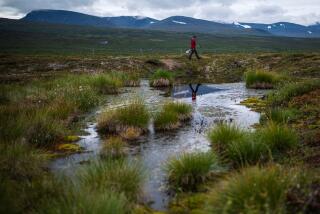Forecast: an iceless Arctic summer
- Share via
A review of existing computer climate models suggests that global warming could transform the North Pole into an ice-free expanse of ocean at the end of each summer by 2100, scientists reported today.
The researchers said that out of the 15 models they looked at, about half forecast that the sea-ice cover -- a continent-sized expanse that shrinks and grows with the seasons -- would seasonally vanish by the turn of the century.
“That may be conservative,” said lead author Mark Serreze, a senior research scientist at the National Snow and Ice Data Center in Boulder, Colo.
One model predicted the Arctic would be ice-free each September as early as 2040, according to the article in the journal Science.
The remaining models showed the presence of some ice beyond 2100, although they agreed there would be significant ice loss if greenhouse gas emissions continue to grow at the current rate.
The computer models were included in a landmark United Nations report last month that blamed human activities for the “runaway train” of global warming.
The disappearance of the ice would lead to a dramatic reshaping of the Arctic that would accelerate warming of the oceans and potentially change precipitation patterns worldwide.
The Arctic’s end-of-summer ice expanses already have been declining by about 9% each decade since the 1970s.
It is possible to see the difference from an airplane heading north from Alaska. “You have to fly a lot longer to get to the ice edge than you used to,” said Josefino Comiso, a satellite imaging expert at NASA’s Goddard Space Flight Center who was not connected to the report.
He and other experts believe the melting will accelerate as more ice disappears and exposes the open ocean, which absorbs heat and melts more ice from below.
“With less and less ice, you have more and more heat,” eventually contributing to further warming around the globe, Comiso said.
The computer forecasts do not apply to Antarctica, where ocean and atmospheric circulation help maintain a much colder climate. There has been little melting of sea ice there.
At its yearly peak each March, floating Arctic ice grows to an average of 6.2 million square miles, more than 1 1/2 times the area of the United States.
By September, it typically shrinks by more than 50%. In 2005, it reached its smallest recorded size: 2.1 million square miles.
The effects of disappearing ice are already being felt, the authors said.
Alaska and Siberia are more vulnerable to waves that erode the coastlines. Indigenous cultures have had to change hunting practices.
And polar bear populations have suffered.
Jacob Sewall, a geoscientist at Virginia Tech University, has suggested that declines in Arctic sea-ice cover during the winter months would reduce winter precipitation in the American West.
“It sets up a relatively large high-pressure [zone] off the west coast of Northern California,” he said. “That deflects the storms into the north, into British Columbia and southern Alaska.”
Loss Arctic ice would not contribute significantly to rising sea levels -- one of the most feared predictions of global warming. When floating ice melts, it does not raise the water level.







